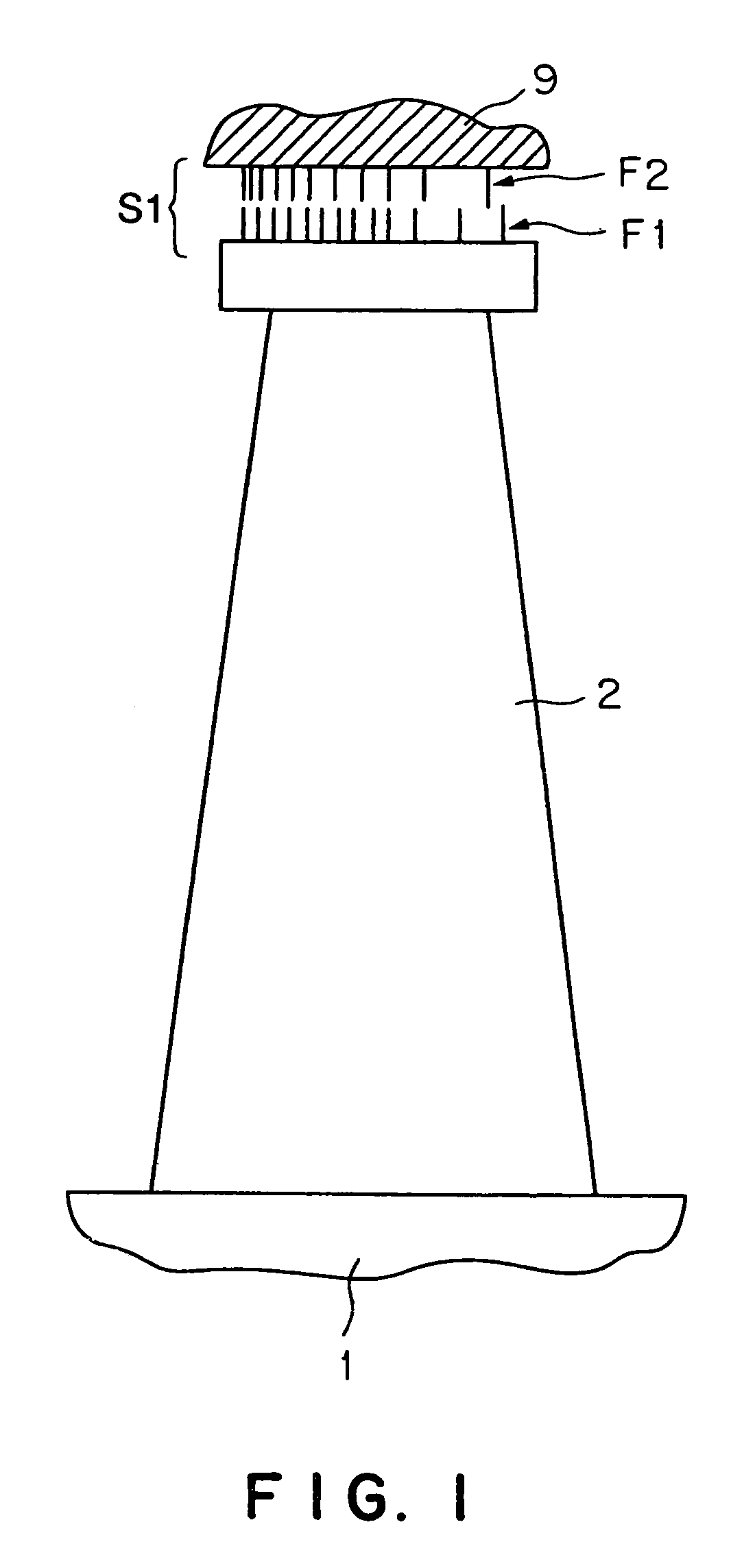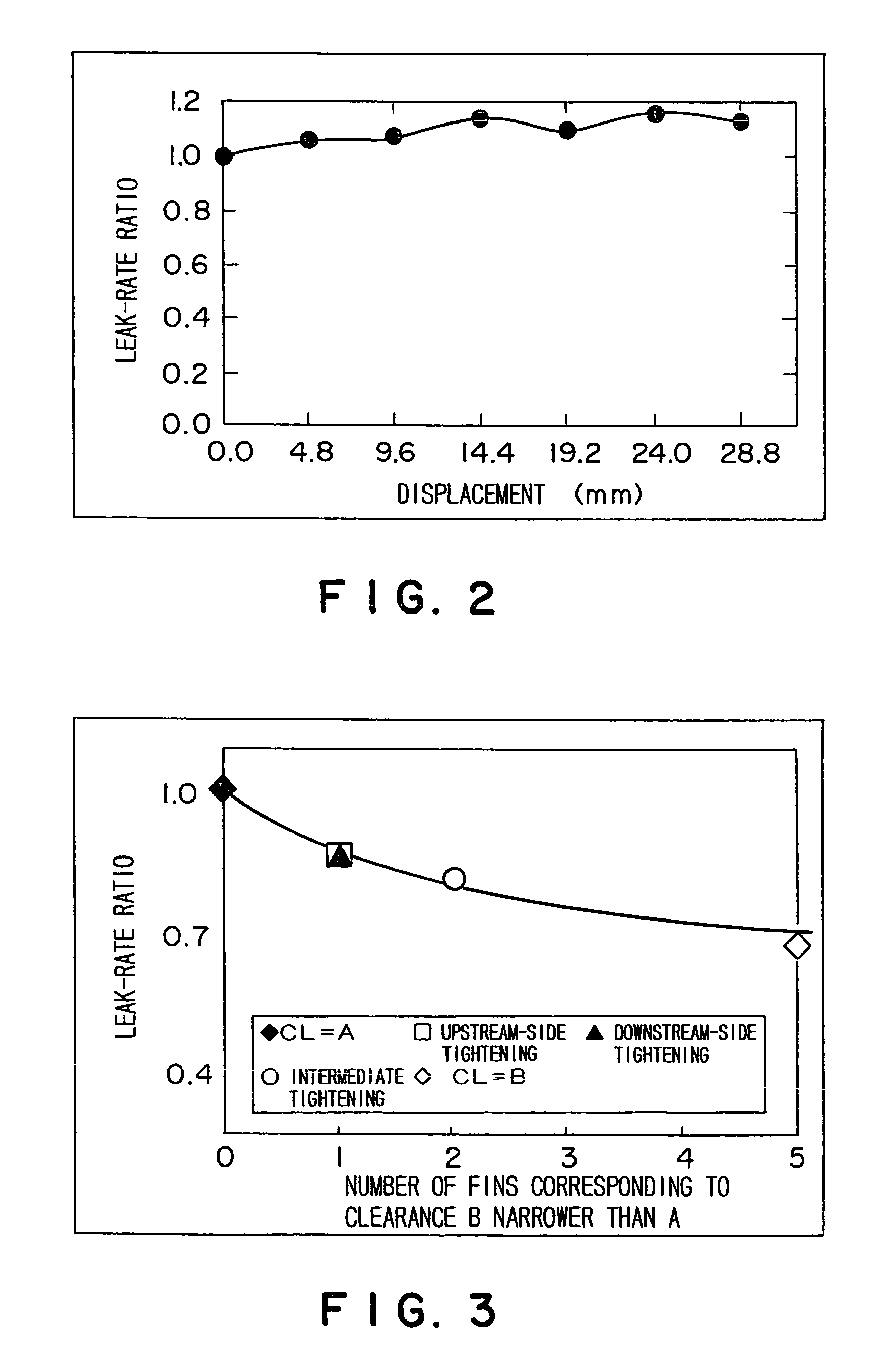Rotary machine with seal
a rotary machine and seal technology, applied in machines/engines, mechanical devices, liquid fuel engines, etc., can solve the problems of increasing the clearance, and reducing the sealing performance of the comb-type sealing device, etc., to achieve the effect of suppressing the reduction of the sealing performan
- Summary
- Abstract
- Description
- Claims
- Application Information
AI Technical Summary
Benefits of technology
Problems solved by technology
Method used
Image
Examples
first embodiment
[0044]A rotary machine in a first embodiment according to the present invention will be described with reference to FIG. 1. FIG. 1 shows an essential part of the rotary machine in the first embodiment, such as an axial-flow turbine. The rotary machine has a rotor 1 supported for rotation about an axis of rotation and provided with a rotor blade 2, i.e. a rotating member, and a labyrinth packing 9, i.e. a stationary member, surrounding the rotor 1. The labyrinth packing 9 is held on an outer ring 3 of a nozzle diaphragm mounted on a casing 6 (FIGS. 8 and 9). A comb-type labyrinth sealing device S1 is disposed in a gap between the outer edge of the rotor blade 2 and the labyrinth packing 9.
[0045]The labyrinth sealing device S1 has a plurality of sealing fins F1 and F2 arranged opposite to each other on the opposite sides of the gap, respectively. The sealing fins F1 and F2 are axially spaced apart at unequal pitches. More specifically, the sealing fins F1 and F2 of the rotary machine ...
second embodiment
[0052]A rotary machine in a second embodiment according to the present invention will be described with reference to FIG. 4. The rotary machine in the second embodiment is provided with a labyrinth sealing device S2. The labyrinth sealing device S2 is the same in construction as the labyrinth sealing device S1 in the first embodiment shown in FIG. 1, except that the labyrinth sealing device S2 differs from the labyrinth sealing device S1 in the arrangement of its sealing fins F1 and F2.
[0053]In the sealing device S2 included in the rotary machine in the second embodiment, the sealing fins F1 on the side of a rotor blade 2 are axially spaced apart at unequal pitches such that the pitches decrease from both ends toward the middle of the row of the sealing fins F1. The sealing fins F2 on the side of a labyrinth packing 9 are axially spaced apart at unequal pitches such that the pitches decrease from one end toward the middle of the row of the sealing fins F2, increase in the middle of ...
third embodiment
[0056]A rotary machine in a third embodiment according to the present invention will be described with reference to FIG. 5. The rotary machine in the third embodiment is provided with a labyrinth sealing device S3. The labyrinth sealing device S3 differs from the labyrinth sealing device S1 in the first embodiment shown in FIG. 1 in that a ridge 35 is formed in the outer edge of a rotor blade 2 and some of the sealing fins F2 are disposed opposite to the ridge 35. The ridge 35 has a width greater than the thickness of sealing fins F1 and F2 (F2′) along the axis of rotation. The labyrinth sealing device S3 is similar in other respects to the labyrinth sealing device S1 included in the rotary machine in the first embodiment.
[0057]The sealing fins F1 on the rotor blade 2 provided with the ridge 35 are axially space apart substantially at equal pitches. Pitches between the sealing fins F2′ (first sealing fins) opposite to the ridge 35 among the sealing fins F2 are smaller than those bet...
PUM
 Login to View More
Login to View More Abstract
Description
Claims
Application Information
 Login to View More
Login to View More - R&D
- Intellectual Property
- Life Sciences
- Materials
- Tech Scout
- Unparalleled Data Quality
- Higher Quality Content
- 60% Fewer Hallucinations
Browse by: Latest US Patents, China's latest patents, Technical Efficacy Thesaurus, Application Domain, Technology Topic, Popular Technical Reports.
© 2025 PatSnap. All rights reserved.Legal|Privacy policy|Modern Slavery Act Transparency Statement|Sitemap|About US| Contact US: help@patsnap.com



